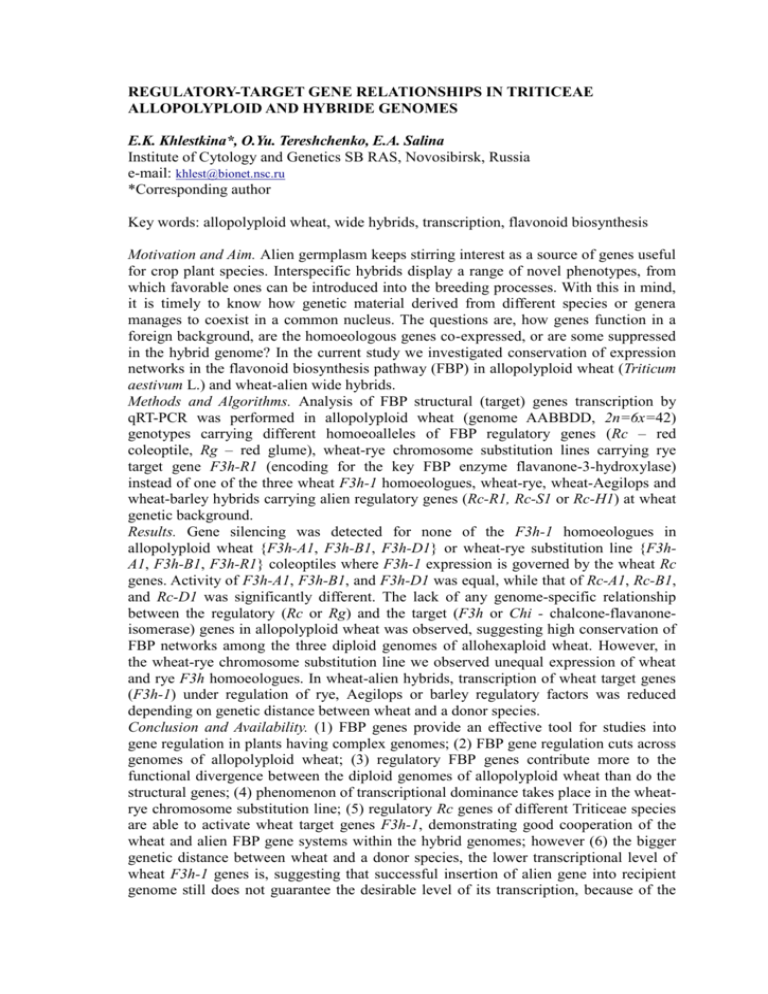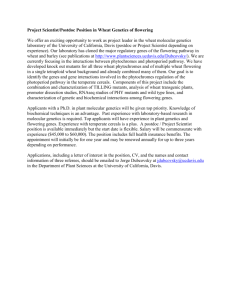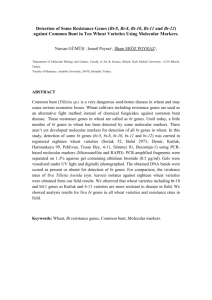REGULATORY-TARGET GENE RELATIONSHIPS IN TRITICEAE
advertisement

REGULATORY-TARGET GENE RELATIONSHIPS IN TRITICEAE
ALLOPOLYPLOID AND HYBRIDE GENOMES
E.K. Khlestkina*, O.Yu. Tereshchenko, E.A. Salina
Institute of Cytology and Genetics SB RAS, Novosibirsk, Russia
e-mail: khlest@bionet.nsc.ru
*Corresponding author
Key words: allopolyploid wheat, wide hybrids, transcription, flavonoid biosynthesis
Motivation and Aim. Alien germplasm keeps stirring interest as a source of genes useful
for crop plant species. Interspecific hybrids display a range of novel phenotypes, from
which favorable ones can be introduced into the breeding processes. With this in mind,
it is timely to know how genetic material derived from different species or genera
manages to coexist in a common nucleus. The questions are, how genes function in a
foreign background, are the homoeologous genes co-expressed, or are some suppressed
in the hybrid genome? In the current study we investigated conservation of expression
networks in the flavonoid biosynthesis pathway (FBP) in allopolyploid wheat (Triticum
aestivum L.) and wheat-alien wide hybrids.
Methods and Algorithms. Analysis of FBP structural (target) genes transcription by
qRT-PCR was performed in allopolyploid wheat (genome AABBDD, 2n=6x=42)
genotypes carrying different homoeoalleles of FBP regulatory genes (Rc – red
coleoptile, Rg – red glume), wheat-rye chromosome substitution lines carrying rye
target gene F3h-R1 (encoding for the key FBP enzyme flavanone-3-hydroxylase)
instead of one of the three wheat F3h-1 homoeologues, wheat-rye, wheat-Aegilops and
wheat-barley hybrids carrying alien regulatory genes (Rc-R1, Rc-S1 or Rc-H1) at wheat
genetic background.
Results. Gene silencing was detected for none of the F3h-1 homoeologues in
allopolyploid wheat {F3h-A1, F3h-B1, F3h-D1} or wheat-rye substitution line {F3hA1, F3h-B1, F3h-R1} coleoptiles where F3h-1 expression is governed by the wheat Rc
genes. Activity of F3h-A1, F3h-B1, and F3h-D1 was equal, while that of Rc-A1, Rc-B1,
and Rc-D1 was significantly different. The lack of any genome-specific relationship
between the regulatory (Rc or Rg) and the target (F3h or Chi - chalcone-flavanoneisomerase) genes in allopolyploid wheat was observed, suggesting high conservation of
FBP networks among the three diploid genomes of allohexaploid wheat. However, in
the wheat-rye chromosome substitution line we observed unequal expression of wheat
and rye F3h homoeologues. In wheat-alien hybrids, transcription of wheat target genes
(F3h-1) under regulation of rye, Aegilops or barley regulatory factors was reduced
depending on genetic distance between wheat and a donor species.
Conclusion and Availability. (1) FBP genes provide an effective tool for studies into
gene regulation in plants having complex genomes; (2) FBP gene regulation cuts across
genomes of allopolyploid wheat; (3) regulatory FBP genes contribute more to the
functional divergence between the diploid genomes of allopolyploid wheat than do the
structural genes; (4) phenomenon of transcriptional dominance takes place in the wheatrye chromosome substitution line; (5) regulatory Rc genes of different Triticeae species
are able to activate wheat target genes F3h-1, demonstrating good cooperation of the
wheat and alien FBP gene systems within the hybrid genomes; however (6) the bigger
genetic distance between wheat and a donor species, the lower transcriptional level of
wheat F3h-1 genes is, suggesting that successful insertion of alien gene into recipient
genome still does not guarantee the desirable level of its transcription, because of the
donor-recipient gene expression networks divergence.






